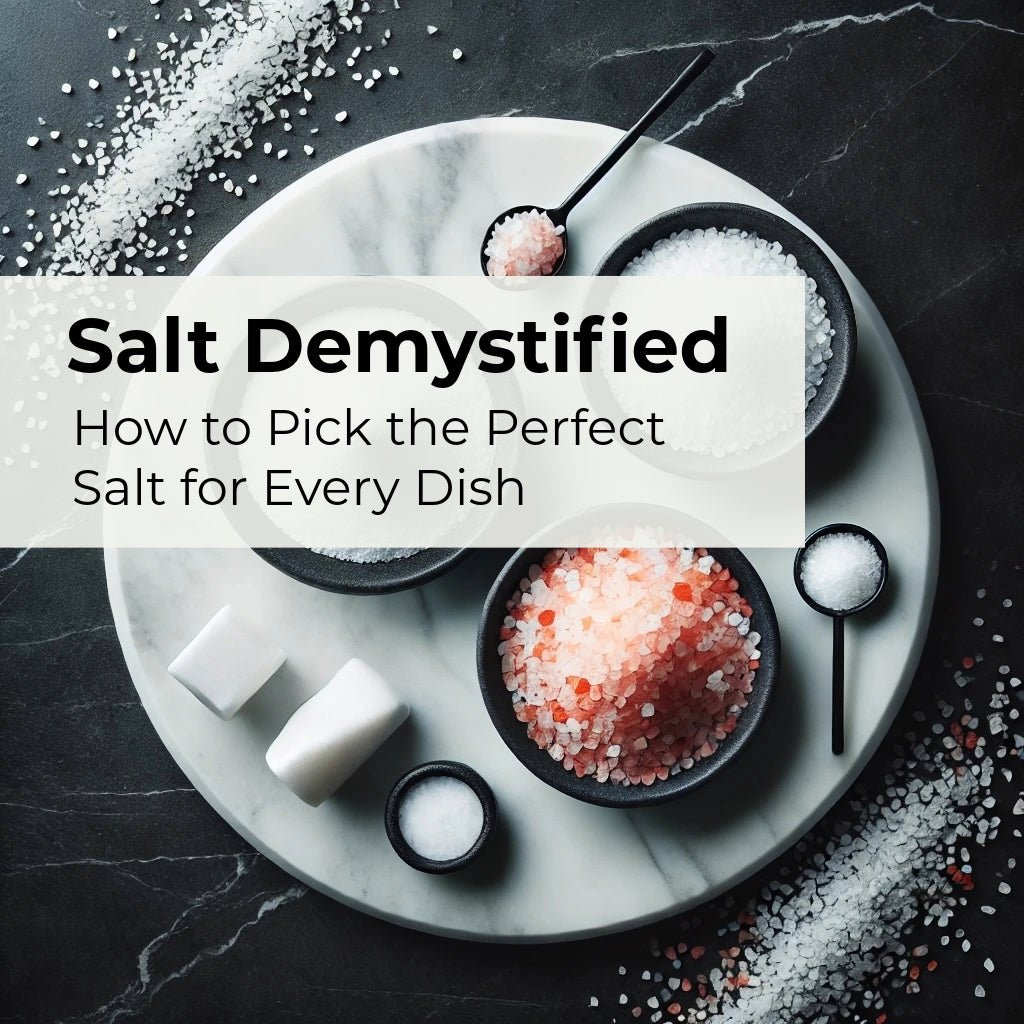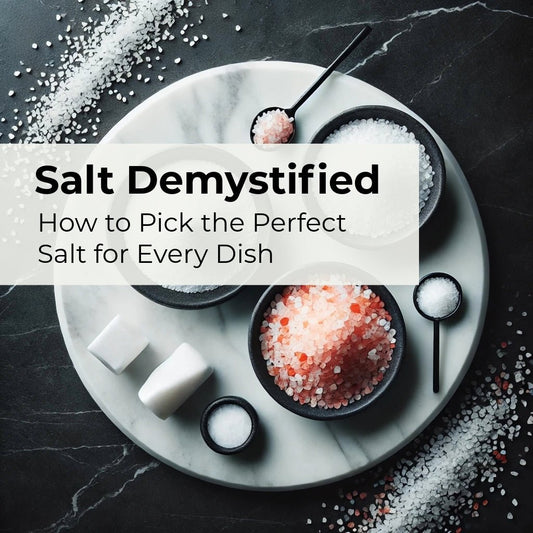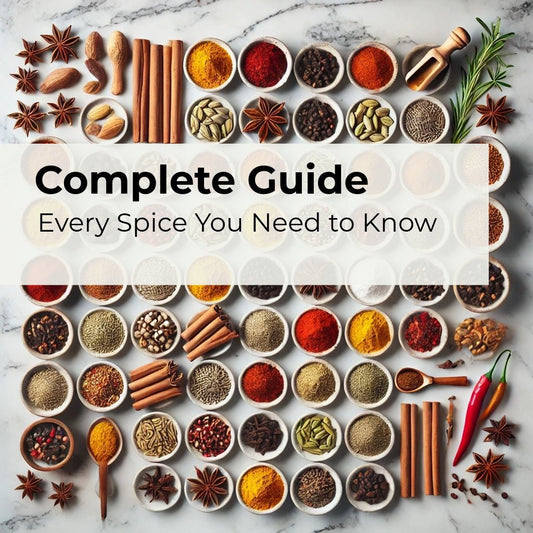
Salt Demystified: How to Pick the Perfect Salt for Every Dish
Share
Salt is one of the most versatile and essential ingredients in the kitchen. This guide will help you understand the different types of salt, where they come from, how to use them, and why the size of the granules can impact your cooking.
Table of Contents
- Types of Salt and Where They Are Mined
- Table Salt
- Sea Salt
- Himalayan Pink Salt
- Kosher Salt
- Fleur de Sel
- Choosing the Right Salt for Your Dish
- The Importance of Granule Size: Why It Affects Your Cooking
- Measuring Salt Correctly
- Conclusion
I added some links for you to buy the different salts if interested. I may get commission at no cost to you if you purchase one.
1. Types of Salt and Where They Are Mined
Salt is harvested in various ways, from deep within the earth to the surface of evaporating seawater. Here are the most common types you’ll encounter:
1. Table Salt (Recommended buy here)
- Where It’s Mined: Typically mined from underground salt deposits. It is highly processed and refined to remove minerals and impurities.
- Common Uses: It dissolves easily and is used in almost every type of cooking, especially for baking where precise measurements are critical.
- Granule Size: Fine and dense, meaning it packs more salt by volume compared to coarser types.
2. Sea Salt (Recommended buy here)
- Where It’s Harvested: Produced by evaporating seawater, commonly in Mediterranean countries like Spain and France.
- Common Uses: With its slightly more complex flavor due to trace minerals, sea salt is great for finishing dishes or adding a subtle crunch.
- Granule Size: Larger crystals compared to table salt, which means a teaspoon of sea salt weighs less and contains less sodium.
3. Himalayan Pink Salt (Recommended buy fine here / coarse here)
- Where It’s Mined: Mined from ancient salt beds in the Himalayan mountains, primarily in Pakistan.
- Common Uses: Known for its vibrant pink color and mineral content, it's often used as a finishing salt or for adding visual appeal.
- Granule Size: Available in both fine and coarse varieties. The coarse version can be ground in a salt grinder for more control over its texture.
4. Kosher Salt (Recommended buy here)
- Where It’s Mined: Extracted from salt mines, typically in the U.S. and other regions with large deposits.
- Common Uses: Due to its flaky texture, it’s a favorite for seasoning meats and general cooking. It’s called kosher salt because it's traditionally used in the koshering process to draw blood from meat.
- Granule Size: Larger flakes mean it dissolves slower and is less dense, so you’ll often need more kosher salt by volume compared to table salt.
5. Fleur de Sel (Recommended buy here)
- Where It’s Harvested: Hand-harvested from shallow seawater ponds, particularly in France.
- Common Uses: A finishing salt known for its delicate, crunchy texture. It’s often used to top dishes like salads, fish, or even desserts like chocolate.
- Granule Size: Fine, irregular flakes that dissolve quickly on food, making it ideal for sprinkling right before serving.
2. Choosing the Right Salt for Your Dish
Different salts can bring out unique flavors and textures in your food. Here's a quick guide to choosing the right salt depending on what you're making:
- For Everyday Cooking: Table salt or kosher salt are versatile and easy to use in most recipes.
- For Finishing Dishes: Try sea salt or Fleur de Sel. Their larger granules and subtle flavors make them perfect for sprinkling on top of food right before serving.
- For Baking: Stick to table salt. Its fine granules dissolve easily, ensuring even distribution without adding crunch. Some bakers also like using kosher salt for a slight textural difference in cookies or breads.
- For Presentation: Himalayan pink salt can add a pop of color, while smoked salts can introduce rich, smoky undertones to meats or roasted vegetables.
3. The Importance of Granule Size: Why It Affects Your Cooking
Understanding the size of salt granules is essential for beginner cooks, especially when following recipes. Different salts can weigh different amounts, even when measured by the same volume (like teaspoons or tablespoons). This is because larger salt crystals take up more space and are less dense than finely ground salt.
Here’s a quick breakdown:
- Fine Table Salt: Packs more sodium in a single tablespoon because the grains are smaller and denser.
- Coarse or Flake Salt: Takes up more space, meaning a tablespoon of kosher or sea salt will be less salty than table salt.
How to Adjust Recipes: If a recipe calls for a teaspoon of fine salt but you’re using a coarse salt like kosher, you may need to add a bit more to achieve the same level of saltiness. As a general rule:
- 1 teaspoon of table salt = about 1.5 teaspoons of kosher salt.
- 1 teaspoon of table salt = about 2 teaspoons of flake salt (like sea salt or Fleur de Sel).
4. Measuring Salt Correctly
Measuring salt precisely can be tricky due to these variations in granule size. Here's how to ensure you're measuring it right:
- Always Level Your Spoon: Whether you're using fine salt or coarse salt, ensure that your teaspoon or tablespoon is leveled off for accuracy.
- Be Mindful of Granule Size: If the recipe doesn’t specify, use table salt for precision. If you’re using a coarser salt, remember to add slightly more.
- Taste as You Go: For salts like kosher or sea salt, it’s helpful to taste your food as you cook, especially since these larger crystals may not dissolve as evenly as finer salts.
5. Conclusion: Elevating Your Cooking with the Right Salt
Understanding the types of salt and how their granule sizes impact your cooking will help you make more informed choices in the kitchen. Whether you’re sprinkling Fleur de Sel on top of a gourmet dish or using kosher salt to season your favorite cut of meat, each type of salt has its place. And when it comes to measuring, a little knowledge about granule density can make a big difference in your final dish.
Remember, salt isn’t just about flavor—it's about balance. Choose the right salt for your cooking needs, and don’t be afraid to experiment with different types to elevate your culinary creations!









